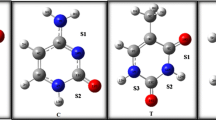Abstract
Molecular electrostatic potential(MEP) maps of azido thymidine (AZT), some of its analogs and derivatives and certain other 2′,3′-dideoxy nucleosides having different anti-HIV activities have been studied. The optimised hybridization displacement charges (HDC) combined with MNDO Löwdin charges, continuosly distributed in three dimension spherically symmetrically as a Slater cloud at each site were used to compute the MEP maps. The negative MEP region near the O5′ sites of these molecules appears to be of primary importance from the point of view of their anti-HIV activity. The roles of the azido group in AZT and fluorine atoms substituted at different positions in the sugar moiety have been evaluated. The azido group in AZT behaves as a strongly electronegative group.
Similar content being viewed by others
Author information
Authors and Affiliations
Additional information
Received: 25 November 1996 / Accepted: 24 March 1997 / Published: 15 April 1997
Rights and permissions
About this article
Cite this article
Chidangil, S., Mishra, P. Structure-Activity Relationship for Some 2′,3′-Dideoxynucleoside Anti-HIV Drugs Using Molecular Electrostatic Potential Mapping. J Mol Med 3, 172–181 (1997). https://doi.org/10.1007/s008940050029
Issue Date:
DOI: https://doi.org/10.1007/s008940050029




